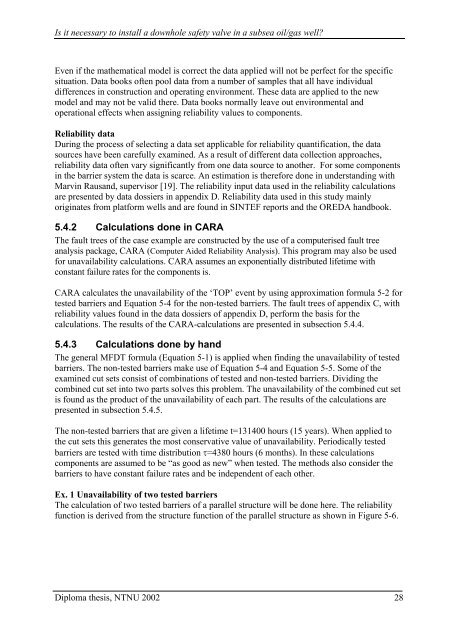Is it necessary to install a downhole safety valve in a subsea ... - NTNU
Is it necessary to install a downhole safety valve in a subsea ... - NTNU
Is it necessary to install a downhole safety valve in a subsea ... - NTNU
You also want an ePaper? Increase the reach of your titles
YUMPU automatically turns print PDFs into web optimized ePapers that Google loves.
<strong>Is</strong> <strong>it</strong> <strong>necessary</strong> <strong>to</strong> <strong><strong>in</strong>stall</strong> a <strong>downhole</strong> <strong>safety</strong> <strong>valve</strong> <strong>in</strong> a <strong>subsea</strong> oil/gas well?<br />
Even if the mathematical model is correct the data applied will not be perfect for the specific<br />
s<strong>it</strong>uation. Data books often pool data from a number of samples that all have <strong>in</strong>dividual<br />
differences <strong>in</strong> construction and operat<strong>in</strong>g environment. These data are applied <strong>to</strong> the new<br />
model and may not be valid there. Data books normally leave out environmental and<br />
operational effects when assign<strong>in</strong>g reliabil<strong>it</strong>y values <strong>to</strong> components.<br />
Reliabil<strong>it</strong>y data<br />
Dur<strong>in</strong>g the process of select<strong>in</strong>g a data set applicable for reliabil<strong>it</strong>y quantification, the data<br />
sources have been carefully exam<strong>in</strong>ed. As a result of different data collection approaches,<br />
reliabil<strong>it</strong>y data often vary significantly from one data source <strong>to</strong> another. For some components<br />
<strong>in</strong> the barrier system the data is scarce. An estimation is therefore done <strong>in</strong> understand<strong>in</strong>g w<strong>it</strong>h<br />
Marv<strong>in</strong> Rausand, supervisor [19]. The reliabil<strong>it</strong>y <strong>in</strong>put data used <strong>in</strong> the reliabil<strong>it</strong>y calculations<br />
are presented by data dossiers <strong>in</strong> appendix D. Reliabil<strong>it</strong>y data used <strong>in</strong> this study ma<strong>in</strong>ly<br />
orig<strong>in</strong>ates from platform wells and are found <strong>in</strong> SINTEF reports and the OREDA handbook.<br />
5.4.2 Calculations done <strong>in</strong> CARA<br />
The fault trees of the case example are constructed by the use of a computerised fault tree<br />
analysis package, CARA (Computer Aided Reliabil<strong>it</strong>y Analysis). This program may also be used<br />
for unavailabil<strong>it</strong>y calculations. CARA assumes an exponentially distributed lifetime w<strong>it</strong>h<br />
constant failure rates for the components is.<br />
CARA calculates the unavailabil<strong>it</strong>y of the ‘TOP’ event by us<strong>in</strong>g approximation formula 5-2 for<br />
tested barriers and Equation 5-4 for the non-tested barriers. The fault trees of appendix C, w<strong>it</strong>h<br />
reliabil<strong>it</strong>y values found <strong>in</strong> the data dossiers of appendix D, perform the basis for the<br />
calculations. The results of the CARA-calculations are presented <strong>in</strong> subsection 5.4.4.<br />
5.4.3 Calculations done by hand<br />
The general MFDT formula (Equation 5-1) is applied when f<strong>in</strong>d<strong>in</strong>g the unavailabil<strong>it</strong>y of tested<br />
barriers. The non-tested barriers make use of Equation 5-4 and Equation 5-5. Some of the<br />
exam<strong>in</strong>ed cut sets consist of comb<strong>in</strong>ations of tested and non-tested barriers. Divid<strong>in</strong>g the<br />
comb<strong>in</strong>ed cut set <strong>in</strong><strong>to</strong> two parts solves this problem. The unavailabil<strong>it</strong>y of the comb<strong>in</strong>ed cut set<br />
is found as the product of the unavailabil<strong>it</strong>y of each part. The results of the calculations are<br />
presented <strong>in</strong> subsection 5.4.5.<br />
The non-tested barriers that are given a lifetime t=131400 hours (15 years). When applied <strong>to</strong><br />
the cut sets this generates the most conservative value of unavailabil<strong>it</strong>y. Periodically tested<br />
barriers are tested w<strong>it</strong>h time distribution τ=4380 hours (6 months). In these calculations<br />
components are assumed <strong>to</strong> be “as good as new” when tested. The methods also consider the<br />
barriers <strong>to</strong> have constant failure rates and be <strong>in</strong>dependent of each other.<br />
Ex. 1 Unavailabil<strong>it</strong>y of two tested barriers<br />
The calculation of two tested barriers of a parallel structure will be done here. The reliabil<strong>it</strong>y<br />
function is derived from the structure function of the parallel structure as shown <strong>in</strong> Figure 5-6.<br />
Diploma thesis, <strong>NTNU</strong> 2002<br />
28


